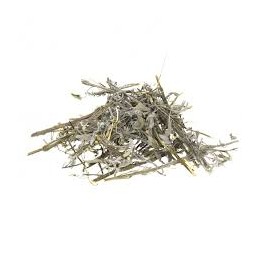
Reference: coriander
Banner



Medical Sage is an herb with a long tradition and versatile health properties. Our online store takes pleasure in presenting this exceptional plant, which has been used in natural medicine for centuries. Medical Sage, also known as Salvia officinalis, belongs to the mint family. Its characteristic silver-green leaves emit a strong aroma that is often utilized as a culinary spice. However, medical sage is not only a wonderful addition to dishes but also a valuable herbal ingredient. In natural medicine, medical sage is highly valued for its antibacterial, anti-inflammatory, and antioxidant properties. Its plant compounds, such as flavonoids, diterpenes, and rosmarinic acid, contribute to its multifaceted health benefits. Medical Sage finds broad application in cases of throat and oral discomfort due to its antiseptic and antibacterial effects. An infusion of medical sage can be used for gargling or as an ingredient in toothpaste.
 Security policy
Security policy
(edit with the Customer Reassurance module)
 Delivery policy
Delivery policy
(edit with the Customer Reassurance module)
 Return policy
Return policy
(edit with the Customer Reassurance module)
 Sage, also known as Salvia officinalis, has many common names in various languages and countries. Here are a few of them:
Sage, also known as Salvia officinalis, has many common names in various languages and countries. Here are a few of them:
 1. What is common sage, and what are its properties ?
1. What is common sage, and what are its properties ?
Common sage (Salvia officinalis) is a medicinal herb from the Lamiaceae family, native to the Mediterranean region. It grows wild in Europe, Asia, and North Africa and is widely used in natural remedies and dietary supplements due to its medicinal properties. Common sage has many medical applications. Its anti-inflammatory, antibacterial, antifungal, and antiviral properties make it useful for treating throat, oral and sinus infections, as well as skin conditions and urinary tract problems. In traditional folk medicine, common sage has also been used as a calming agent and to help with depression, anxiety, and sleep disorders. Common sage is rich in various nutrients, including flavonoids, rosmarinic acid, carnosine, and essential oils. Especially, the essential oils, mainly composed of thujone and camphor, are responsible for its distinct taste, aroma, and therapeutic effects. Due to its properties, common sage is used as a flavoring agent in many dishes, such as meat, soups, salads, and sauces. It can also be used as a tea or infusion to help with various ailments.
 2. What are the uses of common sage in natural and traditional medicine ?
2. What are the uses of common sage in natural and traditional medicine ?
Common sage is a plant from the Lamiaceae family used in natural and traditional medicine for its medicinal properties. Its uses may vary depending on the country and culture. In natural medicine, common sage is often used as an antibacterial and anti-inflammatory agent, as well as a remedy for menopausal symptoms. Many people also use it to improve digestion and soothe sore throats. In traditional medicine, common sage is employed in various forms, including as a tea, tincture, essential oil, ointment, and throat spray. Its most common uses include alleviating inflammation in the mouth, throat, and throat, as well as easing menopausal symptoms like hot flashes and sweating. Common sage contains several valuable chemical compounds, such as flavonoids, rosmarinic acid, carnosine, and triterpenes, which exhibit antioxidant and anti-inflammatory properties. Consequently, it is often used to treat respiratory and digestive conditions and to enhance overall well-being. However, it is essential to note that common sage is not recommended for pregnant and breastfeeding women, as well as for individuals with Parkinson's disease, epilepsy, and hyperthyroidism. It is advisable to consult a doctor before using common sage.
 3. What are the chemical components of common sage, and how do they impact health ?
3. What are the chemical components of common sage, and how do they impact health ?
Common sage, also known as Salvia officinalis, is an herb native to the Mediterranean regions and has been used in natural medicine for centuries. Sage contains several chemical components, including essential oils, flavonoids, tannins, ursolic acid, and rosmarinic acid. Essential oils are the primary active ingredients in sage and account for many of its medicinal properties. They include compounds such as thujone, camphor, terpinen-4-ol, and alpha-terpineol, which exhibit antibacterial, antifungal, and anti-inflammatory effects. Flavonoids and tannins are antioxidants that help combat free radicals and protect cells from damage. Ursolic acid and rosmarinic acid are potent antioxidants that can prevent DNA damage and reduce the risk of developing heart diseases, neurodegenerative disorders, and tumors. Sage's impact on health is broad and encompasses various aspects, including oral health, digestive health, respiratory health, nervous system health, cardiovascular health, and urinary health. Sage can help alleviate symptoms of sore throat, gum inflammation, stomach pain, bronchitis, neuralgia, migraines, joint inflammation, and can improve memory and concentration.
 4. What are the doses and methods of using common sage for medicinal purposes ?
4. What are the doses and methods of using common sage for medicinal purposes ?
Common sage (Salvia officinalis) is a potent medicinal herb used in both natural and traditional medicine. The method of usage and dosages of common sage depend on the specific purpose it is being used for. To prepare a sage infusion, one should pour 1-2 teaspoons of dried or fresh herb into 200 ml of boiling water. The infusion can be consumed three times a day, before or between meals. Externally, the infusion can be used as compresses or mouth rinses on affected areas. The essential oil of common sage can be used orally by adding a few drops to water or tea. Externally, the essential oil is used in baths, massages, or inhalations. When using common sage in tablet or capsule form, the dosage should be determined according to the manufacturer's or doctor's recommendations.
 5. Can common sage interact with other medications or dietary supplements ?
5. Can common sage interact with other medications or dietary supplements ?
Common sage, like many other herbs and dietary supplements, can interact with other medications or supplements. There are certain medications with which the use of common sage can lead to serious interactions. For instance, common sage may lower blood sugar levels, so it should not be used simultaneously with antidiabetic drugs or insulin. Additionally, common sage can affect blood pressure, so caution should be exercised when using it with antihypertensive medications. It should also be noted that common sage may interact with anticoagulant medications, so using it with such drugs should be avoided without consulting a doctor.
 6. What are the contraindications and potential side effects of using common sage ?
6. What are the contraindications and potential side effects of using common sage ?
Common sage is a medicinal plant with many health properties, but its use may not be safe for everyone. Therefore, it is important to be aware of potential contraindications and side effects before using it. Individuals who should avoid using common sage include pregnant and breastfeeding women, children, individuals with liver, kidney, or pancreatic diseases, as well as those with hypertension. Sage may reduce milk production in breastfeeding women and cause uterine contractions in pregnant women, potentially leading to premature labor. Other potential side effects of using common sage may include abdominal pain, diarrhea, nausea, vomiting, headaches, drowsiness, dizziness, allergic skin reactions, and even epileptic seizures in individuals with neurological disorders. It is also not recommended to use common sage before surgery, as it may affect bleeding time and complicate blood control during the procedure. It is essential to remember that common sage can interact with certain medications, including antihypertensive drugs, antidepressants, sleeping pills, and oral contraceptives. Individuals taking these medications should consult a doctor before using common sage.
 7. What are the best methods for cultivating common sage ?
7. What are the best methods for cultivating common sage ?
Common sage is a medicinal herb cultivated in many countries worldwide due to its medicinal and aromatic properties. To achieve the best results, appropriate methods of cultivation and storage of common sage should be employed.
Cultivation methods:
Common sage prefers sunny or semi-shaded positions. The soil should be well-drained and moderately moist. Ideally, the soil pH should be between 6.5 to 7.5. The plant can be grown from seeds or cuttings. The optimal time for sowing is early spring or autumn, and the best time for planting is spring. Common sage grows well in large pots or in the ground, with a spacing of about 30-40 cm.
 8. Can common sage be used in the kitchen, and what are its culinary uses ?
8. Can common sage be used in the kitchen, and what are its culinary uses ?
Common sage is not only a medicinal plant but also a spice that has been used in the kitchen for centuries. Due to its aromatic and flavorful properties, common sage is often used in Mediterranean cuisine, including Italian cuisine, where it is an important ingredient in many traditional dishes. Fresh or dried common sage pairs well with meats such as chicken, turkey, or pork. It can also be added to egg dishes, soups, sauces, and salads. Common sage is also frequently used to flavor olive oil or balsamic vinegar, giving them a distinct taste and aroma. Due to its strong flavor and aroma, common sage should be used in moderation to avoid overwhelming other flavors. It is best to add it to dishes near the end of cooking or frying.
 9. What are the methods of obtaining and producing extracts and essential oils from common sage ?
9. What are the methods of obtaining and producing extracts and essential oils from common sage ?
Common sage (Salvia officinalis) is known for its abundance of chemical compounds that have beneficial effects on human health. That's why it is increasingly used in the production of dietary supplements, as well as cosmetics and aromatic essential oils. Extracts from common sage are typically obtained from the green parts of the plant, such as leaves and stems. The most common method used for this purpose is liquid extraction, which involves extracting chemical compounds from the plant using appropriate solvents such as alcohol, glycerol, or water. Essential oils from common sage are usually obtained through steam distillation of its leaves and flowers. This method involves heating the plant in water and using the resulting steam, which contains essential oils. The steam is then condensed and separated from the water. In the production of essential oils, the extraction process using organic solvents is also used. This method involves placing dried plant material in an organic solvent such as ethanol or hexane, which allows for the dissolution of essential oils. The solution is then separated and left to evaporate, and the resulting essential oil is filtered and ready for use. Products containing extracts and essential oils from common sage are becoming increasingly popular on the market due to their health and cosmetic properties. However, before using them, it is essential to read the manufacturer's instructions and consult with a doctor or pharmacist, especially if you are taking other medications or dietary supplements.
![]() 10. Are there scientific studies confirming the effectiveness of common sage for medicinal purposes, and what are the results of these studies ?
10. Are there scientific studies confirming the effectiveness of common sage for medicinal purposes, and what are the results of these studies ?
Common sage is one of the most commonly used herbs in natural medicine. There are many scientific studies confirming its effectiveness in treating various conditions. Primarily, common sage is known for its antibacterial, antifungal, and anti-inflammatory properties. Studies have shown that extracts from common sage exhibit anti-inflammatory effects in cases of throat, oral cavity, joint, and skin inflammation. Additionally, the essential oil of common sage demonstrates strong antibacterial properties, which can help combat bacterial infections, including E. coli and Salmonella.
Common sage also exhibits antidepressant and anxiolytic effects. Clinical trials have shown that using common sage extract may help reduce symptoms of depression and anxiety. Other studies have indicated that common sage may help alleviate menopause-related symptoms, such as hot flashes and excessive sweating. Extracts from common sage may also aid in relieving digestive symptoms, such as bloating, abdominal pain, and nausea.
 Scientific research on common sage has been conducted at various institutions worldwide, including:
Scientific research on common sage has been conducted at various institutions worldwide, including:
 STORAGE
STORAGE
Common sage is an herb that should be stored properly to preserve its quality and effectiveness. Here are some tips on how to store common sage:
It's essential to store common sage away from moisture and light to preserve its quality. Before use, sieve it thoroughly to remove any traces of soil or other contaminants. Also, keep in mind that drying common sage may lead to the loss of some nutritional components, so it's best to use it within the first year after drying.
 SCIENTIFIC SOURCES
SCIENTIFIC SOURCES

Thank you for your interest in our website dedicated to herbs! We are delighted that you appreciate our work and effort in creating valuable content. If you would like to share our information on your website, we warmly encourage you to do so. However, we kindly ask you to respect our copyright and refrain from copying content without our consent.
If you wish to share our website, you can always provide a link that leads to our page. Not only will this help maintain the integrity of our work, but it will also allow your readers to discover more valuable information about herbs.
Thank you for your understanding and support! If you have any questions or need further information, do not hesitate to contact us.
Reference: coriander
Reference: fenugreek
Reference: ginger
Reference: saw palmetto
Reference: Mugwort (Artemisia vulgaris)
Reference: Boldo (Peumus boldus)
Reference: artichoke
Reference: stevia
Your review appreciation cannot be sent
Report comment
Report sent
Your report cannot be sent
Write your review
Review sent
Your review cannot be sent

Medical Sage is an herb with a long tradition and versatile health properties. Our online store takes pleasure in presenting this exceptional plant, which has been used in natural medicine for centuries. Medical Sage, also known as Salvia officinalis, belongs to the mint family. Its characteristic silver-green leaves emit a strong aroma that is often utilized as a culinary spice. However, medical sage is not only a wonderful addition to dishes but also a valuable herbal ingredient. In natural medicine, medical sage is highly valued for its antibacterial, anti-inflammatory, and antioxidant properties. Its plant compounds, such as flavonoids, diterpenes, and rosmarinic acid, contribute to its multifaceted health benefits. Medical Sage finds broad application in cases of throat and oral discomfort due to its antiseptic and antibacterial effects. An infusion of medical sage can be used for gargling or as an ingredient in toothpaste.